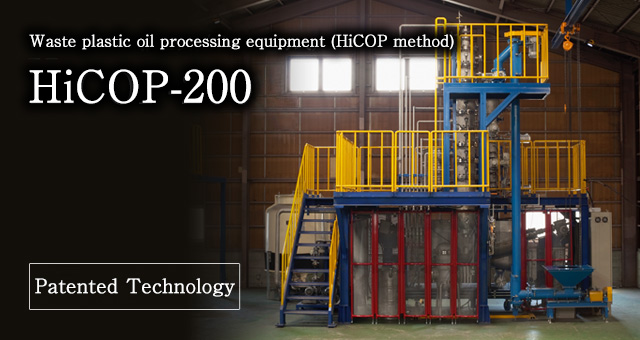Waste plastic oil processing equipment(HiCOP method)

The HiCOP-200 is the first commercially available waste plastic oil converter that uses a catalytic cracking method.
It is now possible to produce high-quality oil that could not be achieved with pyrolysis technology, and is expected to lead to a shift from conventional thermal recycling, which involves burning, to chemical recycling, which has a wide range of uses, including automobile fuel and raw materials for plastics.
Main features
- 1.
- Due to catalytic cracking using a catalyst, the reaction is mild and highly safe.
- 2.
- A high yield (80%) of hydrocarbon oil with no wax content can be obtained.
- 3.
- The device is simple and the equipment cost is low.
- 4.
- Running costs are low because used inexpensive catalysts are used.
- 5.
- Because oil conversion and dechlorination are performed simultaneously, even if a small amount of PVC is mixed in, the residual chlorine in the produced oil is extremely low (70 ppm or less).
Processing capacity
Basic specifications of HiCOP-200
- ・
- Waste plastic processing capacity: 120t/month (200kg/h)
- ・
- Oil production: 120t/month (200kg/h)The yield of produced oil is estimated as 80% (weight equivalent) of the input waste plastic and the specific gravity of produced oil is 0.8.
- ・
- Recommended operating time: 25 days/month (24 hours operation x 25 days = 600 hours)After 3 days of continuous operation, 0.5 days are assumed for catalyst replacement and maintenance.The numbers are a guideline and will vary depending on the quality of the waste plastic input.
Produced oil
The resulting oil is a mixture of approximately 50% gasoline (naphtha) and 50% diesel (light oil). Fractional distillation of these products further expands their uses.
Examples of main uses of produced oil
 Fuel for vehicles, ships, heavy machinery, agricultural machinery, etc.
Fuel for turbine generators, rotary generators, etc.
Fuel for industrial furnaces, incinerators, boilers, etc.
Agricultural and household heating fuel.
Chemical raw materials (for plastic manufacturing).
Fuel for vehicles, ships, heavy machinery, agricultural machinery, etc.
Fuel for turbine generators, rotary generators, etc.
Fuel for industrial furnaces, incinerators, boilers, etc.
Agricultural and household heating fuel.
Chemical raw materials (for plastic manufacturing).




